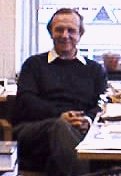John E. Baldwin facts for kids
Quick facts for kids
John E. Baldwin
|
|
|---|---|

Baldwin in the Cavendish Laboratory
|
|
| Born | 6 December 1931 Liverpool, England
|
| Died | 7 December 2010 (aged 79) |
| Alma mater | Queens' College, Cambridge |
| Known for | Cambridge Optical Aperture Synthesis Telescope Aperture Masking Interferometry |
| Spouse(s) | Joyce Cox |
| Awards | Jackson-Gwilt Medal |
| Scientific career | |
| Fields | Astronomy |
| Thesis | A study of cosmic radio sources of large angular size (1956) |
| Doctoral advisor | Martin Ryle |
| Doctoral students | David Saint-Jacques, Peter Tuthill |
John Evan Baldwin (born December 6, 1931 – died December 7, 2010) was a brilliant British astronomer. He worked at the Cavendish Astrophysics Group in Cambridge, England, starting in 1954. He was very important in developing new ways to study space. These methods included interferometry for radio waves and later for light waves, as well as a technique called lucky imaging.
Contents
Early Life and Studies
John Baldwin was born in Liverpool, England. He started studying at Queens' College, Cambridge in 1949. He remained connected to the college throughout his life. From 1999 until his death in 2010, he was a special "Life Fellow" there.
Exploring Space with Radio Waves
John Baldwin joined the Cavendish Astrophysics Group in 1954. This group was known for its work in Radio Astronomy. Radio astronomy uses special telescopes to detect radio waves coming from space. These waves help us learn about objects we can't see with our eyes.
Baldwin played a big part in improving a technique called interferometry. This method combines signals from several smaller telescopes. It makes them act like one giant telescope. This allows astronomers to see much finer details in space.
Using these new methods, he created the very first maps of radio waves from the Andromeda Galaxy. He also mapped the Perseus Cluster. He studied many active galaxies, which are galaxies with very bright centers.
Seeing More Clearly with Light
Later in his career, John Baldwin helped develop optical interferometry. This is similar to radio interferometry but uses light waves instead. In 1985, he performed the first observations using a technique called Aperture Masking Interferometry. This method helps overcome the blurring effects of Earth's atmosphere.
He then led the building and operation of the Cambridge Optical Aperture Synthesis Telescope. This telescope was a major step forward for observing stars and other objects with high detail. He also helped create the lucky imaging method. This technique takes many quick pictures and picks only the clearest ones. This helps astronomers get sharper images of distant objects.
Awards and Recognition
In 2001, John Baldwin received the Jackson-Gwilt Medal. This award recognized his important technical contributions. It honored his work in both interferometry and aperture synthesis. These are key methods for making clearer and more detailed observations of the universe.

